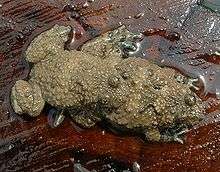Bombinatoridae
| Bombinatoridae Temporal range: Pliocene–Recent | |
|---|---|
 | |
| Bombina variegata | |
| Scientific classification | |
| Kingdom: | Animalia |
| Phylum: | Chordata |
| Class: | Amphibia |
| Subclass: | Lissamphibia |
| Superorder: | Batrachia |
| Order: | Anura |
| Suborder: | Archaeobatrachia |
| Family: | Bombinatoridae Gray, 1825 |
| Genera | |
| | |
| Distribution of Bombinatoridae (in black) | |
The Bombinatoridae are often referred to as fire-bellied toads because of their brightly colored ventral sides, which show they are highly toxic. This family includes two genera, Barbourula and Bombina, both of which have flattened bodies.
Bombina species are warty, aquatic toads about 7 cm (2.8 in) in length, and most noted for their bright bellies. They often display the unken reflex when disturbed; the animal will arch its back and limbs to expose the bright belly, and may turn over on its back. This acts as a warning to predators.[1] The vocal behavior of some Bombina sp. is unusual in that the call is produced during inhalation rather than exhalation as in other frogs. They lay pigmented eggs in ponds.
Barbourula species occur in the Philippine Islands and Borneo, while Bombina species are found throughout Eurasia. They are slightly less colored than Bombina, and possess webbed fingers in addition to webbed toes. Characteristics of tadpoles of Barbourula are unknown.
Barbourula was considered to be situated intermediate between Discoglossus and Bombina, but closer to the latter, so was added to the Bombinatoridae when that family was split from the Discoglossidae.
Fossil Bombina specimens are known from the Pliocene to the Pleistocene; on fossils of Barbourula are known.
Species
Family Bombinatoridae
- Genus Barbourula
- Barbourula busuangensis - Philippine flat-headed frog or Busuanga jungle toad
- Barbourula kalimantanensis - Bornean flat-headed frog or Kalimantan jungle toad
- Genus Bombina
- Bombina bombina (Linnaeus, 1761) – European fire-bellied toad
- Bombina lichuanensis Ye and Fei, 1993 – Lichuan bell toad
- Bombina fortinuptialis Tian & Wu, 1978 – large-spined bell toad or Guangxi firebelly toad
- Bombina microdeladigitora Liu, Hu & Yang, 1960 – Hubei firebelly toad, considered a synonym of B. maxima
- Bombina maxima (Boulenger, 1905) – Yunnan firebelly toad
- Bombina orientalis (Boulenger, 1890) – Oriental fire-bellied toad
- Bombina pachypus (Bonaparte, 1838) – Apennine yellow-bellied toad
- Bombina variegata (Linnaeus, 1758) – yellow-bellied toad
References
- San Mauro, Diego; Mario Garcia-Paris; Rafael Zardoya (December 2004). "Phylogenetic relationships of discoglossid frogs (Amphibia:Anura:Discoglossidae) based on complete mitochondrial genomes and nuclear genes". Gene. 343 (2): 357–66. doi:10.1016/j.gene.2004.10.001. PMID 15588590.
- San Mauro, Diego; Miguel Vences; Marina Alcobendas; Rafael Zardoya; Axel Meyer (May 2005). "Initial diversification of living amphibians predated the breakup of Pangaea". American Naturalist. 165 (5): 590–9. doi:10.1086/429523. PMID 15795855.